A.M. Jensen and M.S. Hajej
Axel Martin Jensen is an
independent dry-zone forestry
consultant. He has spent over six
years in Mauritania and elsewhere as
a Technical Consultant in the FAO
Dune Stabilization and Fixation
Project. He currently resides in
Poutet en Bas, France.
Mohamed Sahbi Hajej is Director
General of the Institution de la
Recherche et de l'Enseignement
Supérieur Agricoles, Ministry of
Agriculture, Tunis, Tunisia.
Protection of the main road crossing Mauritania from west to east - which was sanded over as a result of linked problems of drought, settling of nomads and degradation of woody cover.
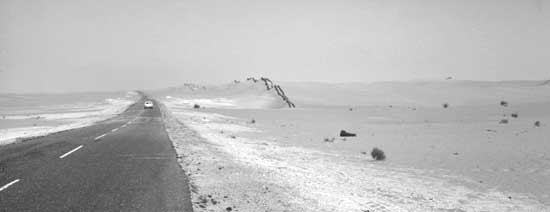
Longitudinal live dunes blending into a counter-dune along the Road of Hope, 25 km from Nouakchott (in the foreground is an area of consolidated lake sediment)
- HÉLÉNA JENSEN
When Mauritania gained independence in 1960, the plan to construct a road linking the new capital, Nouakchott, with the east of the country became a major political issue (Feral, 1983). Construction of the road, known as the "Route de l'espoir", the Road of Hope, began in the early 1970s. When the road was completed at Néma in the early 1980s, it covered 1 200 km and achieved the physical unification of the country, connecting its six richest agricultural and agripastoral zones. About 1 000 km of the road are on soils of aeolian origin.
The existence of this road and the water along its route favoured a process of sedentarization of the predominantly nomadic populations and a concentration of human and animal pressure on an ecosystem already weakened by the long drought of the 1970s and 1980s, when rainfall was reduced to 40 to 50 percent of its prior levels (Table 1). As a consequence of the settlements, vegetation cover was destroyed, the sands began to move, and the road became sanded over in more and more places and over increasingly long segments. By 1991, the Nouakchott-Boutilimit section was sanded over for more than 60 percent of its length.
TABLE 1. Decrease in rainfall during the 1971 to 1987 drought, as compared with the period 1941 to 1970 |
|||
Climatic zone |
Average rainfall (mm/year) |
Loss (%) |
|
1941-1970 |
1971-1987 |
||
Saharo-Sahelian |
152.2 |
77.1 |
49 |
Sahelian proper |
309.0 |
176.8 |
43 |
Source: DPN, 1989. |
|||
This article discusses soil degradation along the road, its causes and various ways of countering the sanding over of the road, together with the costs and benefits of such methods. It is demonstrated that where annual rainfall is less than 100 mm, protection of the road with barriers of inert materials is practical and much more economical than mechanical clearing of sand from the road. Where annual rainfall is over 100 mm, reforestation provides permanent protection of the road and is viable in both financial and socio-economic terms.
When the Road of Hope was planned in the 1960s, there was so little moving sand along the route that no protection work was anticipated. In the five years from 1986 to 1991, however, the total sanded length on the 600 km Nouakchott-Kiffa segment increased from 70.8 to 149.6 km (Table 2), representing a sanding rate of 15.7 km or 2.6 percent per year.
TABLE 2. Sanding-over rate of the Road of Hope |
|||
Sectiona |
Total length (km) |
Length sanded over (km) |
|
1986b |
1991c |
||
Nouakchott-Boutilimit |
150 |
41.2 |
92.4 |
Boutilimit-Aleg |
150 |
12.6 |
14.3 |
Aleg-Cangarafa |
100 |
11.9 |
33.9 |
Cangarafa-Kiffa |
200 |
5.1 8.5 |
|
Total Nouakchott-Kiffa |
600 |
70.8 |
149.1 |
a See map. |
|||
The sand was set in motion by the biological and socio-economic effects of the severe drought of the 1970s and 1980s. Life in Mauritania underwent profound changes during the drought. In 1965, 73 percent of the population of Mauritania was nomadic, whereas in 1985 the figure was only 12 percent (Table 3). Drought was not a new phenomenon in Mauritania (Winstanley, 1973), but transhumance across national borders decreased and the exploitation of vegetation around human settlements intensified.
TABLE 3. Way of life in 1965 and 1988 |
||
Way of life |
Percentage of total population |
|
1965 |
1988 |
|
Nomads |
73 |
12 |
Sedentary rural population |
18 |
48 |
Urban population |
9 |
40 |
Source: National Statistics, 1989. |
||
In 1988, urbanization in Mauritania reached 40 percent, the highest in the subregion after that of Senegal. Migration, settling and urbanization were also a consequence of the fact that rainfed crops could be grown only in the southern part of the country, which as a result received a large influx of people during the drought. As an example, Table 4 illustrates the migration of people along a north-south line running through Kiffa, the regional capital of Assaba.
The Road of Hope was another magnet for nomads as they settled. This settling, occurring in a climatic zone with annual rainfall of 60 to 325 mm, was primarily urban. Thus the annual growth rate of the town of Boutilimit, for example, which had previously been 2.4 percent, increased to 13.1 percent in the period 1971 to 1978, despite the town's location on the 100 mm isohyet. The formation of small settlements along the road was facilitated by the presence of wells drilled when the road was being built.
Having lost a large part of their livestock, the former nomads at first relied on food aid brought in along the road, but in due course they developed other economic activities, particularly small trade, which was facilitated by the existence of the road.
The small livestock of the now settled population and the search for fuelwood along the road degraded the woody cover, which was already fragile as a result of the drought. The loss of cover provoked wind erosion and the sanding over of the road.
TABLE 4. Migration of people from north to south in Mauritania, 1977 to 1987 |
||||
Region |
Rainfall 1971-1987 |
Sedentary population |
Growth rate per year |
|
1977 |
1987 |
|||
Tagant |
50-180 |
74 880 |
46 741 |
- 4.6 |
Assaba |
150-320 |
20 875 |
40 419 |
+ 3.8 |
Guidimaka |
290-490 |
83 231 |
154 325 |
+ 6.4 |
Source: 1977 National Census and 1987 Census maps. |
||||
A few words on winds and dune geomorphology are needed in order to allow a better grasp of how protection measures along the road work.
The wind is multidirectional, with prevailing winds from the northeast from October to May and from the northwest from June to September. About 30 percent of the winds are capable of causing wind erosion. The direction of the resulting displacement of dunes is shown on the map.
Wind erosion creates longitudinal live dunes on sandy substrata and barchans (moving crescent-shaped dunes) on packed substrata (Mainguet, 1984, 1985). Longitudinal live dunes have an oscillating movement at their crests, and their bodies spread southwards at an annual rate of 10 to 20 m (Jensen, 1993). Between live dunes, loose sand is carried by the wind. Barchans on packed substrata move in the direction of the wind, the speed depending on the height of the dune and the force of the wind.
The live dunes are the ones that block the road, whereas loose blown sand causes no obstruction to traffic.
Dune soils are twice as porous as clay soils; they absorb twice as much moisture and lose half as much to evaporation. They also release their retained water more easily to plants. A 50 mm rain shower will moisten sand to a depth of 50 to 100 cm, but clay to barely 25 cm. The ten-month dry period dries out a surface layer of only 40 cm on dune soil, whereas it can dry out a layer up to 1 m deep on clay soil. Dune soils therefore have a favourable water balance even in the desert, while clay soils form a fairly unfavourable substratum for perennial vegetation in dry zones.
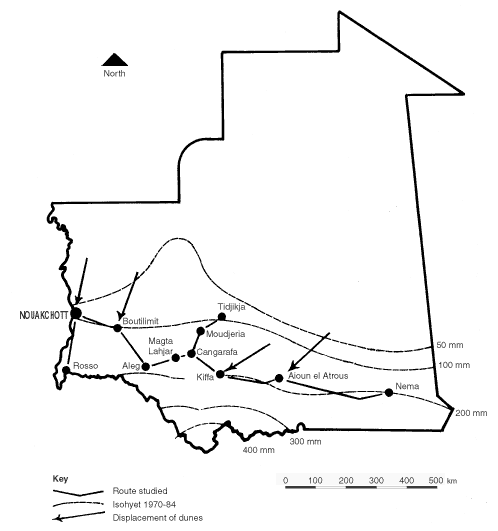
Map of Mauritania, showing the segments of the road studied, isohyets and the direction of the displacement of dunes
Control techniques were mainly developed by an FAO pilot project which protected about 12 km of the Road of Hope within the three years from 1983 to 1986 (FAO, 1988).
An experimental scheme for dune stabilization was set up 25 km from Nouakchott. Two segments, 1 km each, were treated using two different techniques. Along the first segment, the road was protected by setting up, over an area 150 m wide, a grid of woven fencing made from the flexible branches of the indigenous shrub Leptadenia pyrotechnica, with rows 20 to 40 m apart. In the grid between fences, various tree species (Balanites, Leptadenia, Parkinsonia and Prosopis species) were planted. Each seedling received a total of 200 litres of water during the first years. The system was maintained by replacing sanded-over fences with new ones.
Along the second 1 km segment, an artificial dune, also called a "counter-dune", was constructed parallel to and 50 m to the north of the road, protected by two rows of the same kind of Leptadenia fencing. This counter-dune stopped sand from crossing the road in the form of dunes, while letting loose sand cross.
In both systems used along the Nouakchott-Boutilimit section, which has less than 100 mm of annual rainfall, the dunes between the protective system and the road had been cleared away by the wind after a year and a half, and the road stayed clear of dunes over the years that the system was maintained. Three years after the last maintenance, the road was again extensively sanded over, and now only a few shrubs of Prosopis juliflora are left to bear witness to the planted section. These results indicate that continued regular maintainance is essential for all mechanical dune stabilization work.
On the segment of the road between Aleg and Nema, the protection was achieved mainly by afforestation (Khatteli, 1989).
Constraints on growing trees in dune zones are the rapid drying of the soil surface, wind erosion which uproots seedlings, dune movement which buries them and abrasion of the seedlings by sand grains moving along the surface of the ground. All of these constraints can be overcome by planting larger seedlings at a good depth.
The most important afforestation scheme was that of Magta Lahjar (isohyet 150 mm), where 335 ha were planted with Prosopis juliflora, Parkinsonia aculeata and Leptadenia pyrotechnica. Table 5 gives the results of a systematic survey of all the Prosopis plots.
Forestry production from these Prosopis plantations is promising. Dry above-ground biomass production in Kiffa (isohyet 200 mm), for instance, was measured to be 2 tonnes per hectare per year.
Refinements in methods to protect Mauritania's roads against sanding show that protection is technically possible by using barriers of inert materials if rainfall is insufficient, and can be carried out mainly by afforestation where annual rainfall is above 100 mm. Production from these stands could even bring in a worthwhile income.
The 335 ha greenbelt at Magta Lahjar has given total and lasting protection from sand on 6.7 km of the road - or 50 ha of trees per kilometre of road. On another site, between Kiffa and Néma, a 25 ha belt was sufficient to protect 0.75 km of road (33 ha per kilometre). It is estimated that a belt 400 to 500 m wide will generally suffice to ensure the protection of the road and that the production from this belt could cover the maintenance costs.
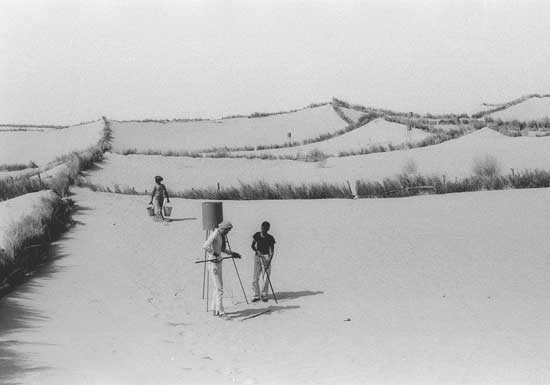
Grid of branch fences created to stabilize the sand dunes along the Road of Hope
- FAO/11046-A-27/T. FENYES
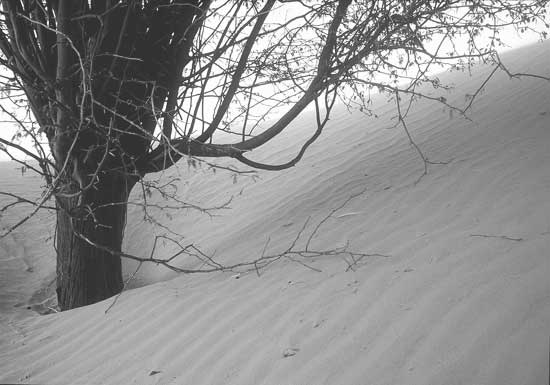
Leptadenia tree in the sands of Mauritania
- FAO/18831/I. BALDERI
The FAO Dune Stabilization and Fixation Project worked out the costs of dune stabilization in detail (summarized in Jensen, 1993).
For the Nouakchott-Boutilimit section, the cost of counter-dunes has been calculated at $US28 000 per kilometre over five years. It is estimated that the annual maintenance costs of counter-dunes level out at US$2 500 per kilometre from the fourth year onwards. The annual cost of mechanical road clearance with large machines such as bulldozers, as carried out by the Public Works Department, was US$13 600 per kilometre on the Nouakchott-Boutilimit section (Limane, 1991). Thus, road protection with counter-dunes pays off through savings in mechanical road clearance over three years.
Yet despite the excellent cost-benefit ratio for protection work using inert barriers on this section, the pilot schemes were not maintained. Why? The problem was primarily a question of lack of collaboration between the Nature Protection Directorate, which was in charge of the pilot project, and the Public Works Directorate, which was to take over the project, and the resulting lack of donor coordination. On the contrary, the Road Maintenance Department was able to obtain funding to clear the road mechanically, even though it was more costly.
The cost of afforestation has been estimated at US$450 per hectare with no watering, or US$500 per hectare with 20 litres of water at the time of planting. A forest strip 200 m wide will thus cost between $8 900 and $10 200 per kilometre. Limane (1991) estimated that the annual cost of clearing the road with Public Works Department machinery was $2 600 per kilometre on the Boutilimit-Kiffa section. Thus, the cost of protection also pays off here through savings in mechanical road clearance over a few years. In addition, the income from forest products could provide an estimated additional income of US$760 per kilometre per year.
TABLE 5. Survey of Prosopis juliflora planted on live dunes 0.5 to 2 m high with little mechanical protection in the Magta Lahjar greenbelt |
||||||
Year of planting |
Planting method |
1988 survey |
||||
Age |
Success rate |
Average Height |
Dry above ground biomass |
Carbonizable biomass |
||
1984 (148 mm) |
Planting of 5-month seedlings with collar at a depth of 20 cm during rains |
4 |
83 |
4.8 |
19.6 |
10.0 |
1985 (177 mm) |
Planting of 3-month seedlings with collar at a depth of 10 cm, with 10 litres of water |
3 |
56 |
4.2 |
10.3 |
4.8 |
1986 (98 mm) |
Planting of 3-month seedlings with collar at a depth of 10 cm, with 10 litres of water |
2 |
70 |
3.2 |
4.3 |
1.4 |
While mechanical road clearance costs are paid mostly in foreign currency, the proportion paid in foreign currency is only 20 percent for counter-dunes and 10 percent for afforestation.
Between improved mastery of techniques and people's participation, it was possible to reduce direct costs six to seven times between 1983 and 1992.
Helles and Jørgensen (1989) studied the socio-economic benefits of the protection of Magta Lahjar (5 900 inhabitants in 1987), comparing it with Cangarafa (2 500 inhabitants in 1987), another town lying on the Road of Hope. The main results of this study are summarized in Table 6. Households in the protected town enjoyed an economic growth of 5 percent per year, while the unprotected town experienced negative growth. The most significant observation in the study was that the people in the protected town invested their surplus locally, while those in the unprotected town exported their surplus.
Protection of the road is economically viable in both socio-economic and financial terms and has helped local people regain confidence in the economic future of their area. However, people's participation cannot be solicited for sections of road that are far from settled areas; thus operations in remote areas have to be carried out under State supervision.
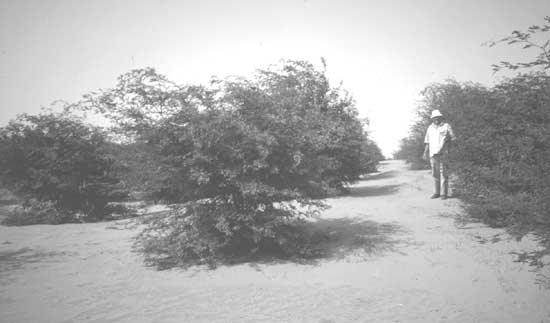
Prosopis juliflora at Magta Lahjar two years after plantation; large seedlings were planted at a good depth and given no further water
- H. JENSEN
With the exception of the 150 km from Nouakchott to Boutilimit, where rainfall is the essential factor in the degradation of natural vegetation, the road is only threatened with sanding at points near villages or water - in other words, points influenced by human settlement.
TABLE 6. Main differences in the economic life of Magta Lahjar, a town protected against sanding, and Cangarafa, a sanded town |
||
Socio-economic indicator |
Magta Lahjar (protected) |
Cangarafa (sanded) |
Average monthly household income, 1984 |
US$176 |
US$224 |
Average monthly household income, 1989 |
US$223 |
US$164 |
Average monthly household investment, 1989 |
US$25 |
US$31 |
Proportion of local investment |
95% |
36% |
Average price of plots of land purchased |
US$330 |
US$90 |
Source: Helles and Jørgensen, 1989. |
||
People will obviously be motivated to protect their own locality from sanding over, but they have to be shown that it is possible. The FAO Dune Stabilization and Fixation Project therefore started as a State-supervised pilot project. However, after only one year, when people saw that trees could be planted directly in dunes with no watering, villages requested the support of the project in protection of their own areas. This gave the project an opportunity to develop a participatory methodology based on a contractual relationship between the project and the inhabitants (Lund, 1998). The contracts specified the responsibilities and contributions of each of the partners, as well as the ownership of the scheme, and were negotiated with the people and signed by their representatives.
The reproducibility of the techniques and the participatory approach have now been demonstrated. From 1993 to 1997, 14 years after the launching of the project, the results were clear: 226 new protected sites, of which several were on the Road of Hope; 1 000 km of Leptadenia and Balanites branches cut, transported by animal traction and planted by the population; more than 1.2 million plants produced in 226 small temporary nurseries created and managed mostly by women; about 1 million trees planted on 2 100 ha. More than 70 sites were protected at the initiative of local groups, with only technical assistance from the administration, and with the direct costs of protection reduced from 31 to 89 percent depending on the work. The fight against sanding has become a part of the technical and socio-economic traditions of the region. Although degradation along the Road of Hope is likely to continue as new villages appear and existing villages grow, it now engenders the reflex to protect and rehabilitate the built-up areas - and the road.
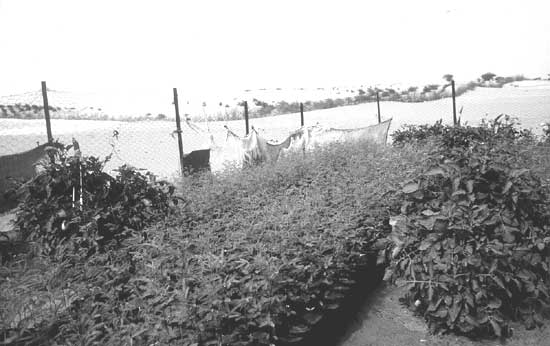
Temporary tree nursery at Tiguint, Mauritania, 100 km south of Nouakchott, for afforestation of sand dunes
- FAO/18847/I. BALDERI
Bibliography
Aydemir, H. 1991. Étude de faisabilité de la protection de la Route de l'Espoir. Étude technique. UNSO project UNSO/MAU/89/X52. Nouakchott, Mauritania, Direction de la Protection de la Nature.
Direction de la Protection de la Nature (DPN), Mauritania. 1989. Programme régionaux de lutte contre la désertification. World Bank project UNSO/MAU/85/X04 and FAO project PNUD/MAU/86/007. Nouakchott.
FAO. 1988. Programme de stabilisation et de fixation des dunes en Mauritanie. Provisional Report. FO: UNSO/DES/MAU/82/001. Rome.
Feral, G. 1983. Le tambour des sables. Paris, Editions France-Empire.
Helles, F. & Jørgensen, P. 1989. Socio-economic study on the towns of Magta Lahjar and Cangarafa. World Bank project UNSO/MAU/85/X04. Nouakchott, Mauritania, Direction de la Protection de la Nature.
Jensen, A.M. 1993. Protection des routes contre l'ensablement en Mauritanie. New York, USA, United Nations Office to Combat Desertification and Drought (UNSO).
Khatteli, H. 1989. Rapport d'activité 1988. FAO project UNSO/MAU/006/NSO. Nouakchott, Mauritania, Direction de la Protection de la Nature.
Kocks Consult. 1987. Étude d'entretien du réseau routier mauritanien. Nouakchott, Mauritania, Ministère de l'Équipement.
Limane, A.O. 1991. Étude de la faisabilité de la protection de la Route de l'Espoir. FAO project UNSO/MAU/89/X52. Nouakchott, Mauritania, Direction de la Protection de la Nature.
Lund, S. 1998. Participation? A question of praxis. A discussion of the "theories" of participatory development based on experiences from a sand dune fixation project in Mauritania 1982-1990. Dissertation. Roskilde University, Denmark.
Mainguet, M. 1984. Cordons longitudinaux (sandridges), dunes allongées à ne plus confondre avec les sifs, autres dunes linéaires. In Le Vent, mécanisme d'érosion, de dégradation, de désertification. Travaux de l'Institut de Géographie de Reims, 59/60: 61-83.
Mainguet, M. 1985. A dynamic classification of mobile dunes. In Sand dure stabilization, shelterbelts and afforestation in dry zones, p. 17-25. FAO Conservation Guide No. 10. Rome, FAO.
National Statistics. 1989. Recensement de la population 1988, République Islamique de la Mauritanie. Nouakchott, Mauritania.
Winstanley, D. 1973. Rainfall patterns and general atmospheric circulation. Nature, 245: 190-194.